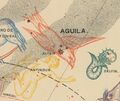Aquila: Difference between revisions
No edit summary |
IanRidpath (talk | contribs) (→Transfer and Transformation of the constellation: Added a link) |
||
| (4 intermediate revisions by 3 users not shown) | |||
| Line 8: | Line 8: | ||
=== Transfer and Transformation of the constellation === |
=== Transfer and Transformation of the constellation === |
||
<gallery> |
|||
File:Aratea 54v and 55r.jpg|Aquila with Sagitta, Leiden Aratea, Fol. 54v and 55r, between circa 830 and circa 840 |
|||
File:Aquila Uranometria.jpg|Aquila et Antinous (Bayer 1603) |
|||
File:Johannes Hevelius - Prodromus Astronomia - Volume III "Firmamentum Sobiescianum, sive uranographia" - Tavola R - Aquila et Antinous.jpg|"Aquila et Antinous" in Hevelius (1690) in "Firmamentum Sobiescianum, sive uranographia" in volume "Prodromus Astronomia" |
|||
File:Sidney Hall - Urania's Mirror - Delphinus, Sagitta, Aquila, and Antinous.jpg|"Delphinus, Sagitta, Aquila, and Antinous", plate 13 in [http://www.ianridpath.com/atlases/urania.html ''Urania's Mirror''], a set of celestial cards accompanied by ''A familiar treatise on astronomy ...'' by Jehoshaphat Aspin (1825). London. Astronomical chart, 1 print on layered paper board : etching, hand-colored. |
|||
File:1776 - John Flamsteed - L'Aigle, Antinous, La Fleche, Le Renard, Le Dauphin (Aquila, Sagitta, Vulpecula & Anser Delphinus).jpg|Aquila et Antinous, 1776 - Jean Fortin/ John Flamsteed - L'Aigle, Antinous, La Fleche, Le Renard, Le Dauphin (Aquila, Sagitta, Vulpecula & Anser Delphinus, [https://www.raremaps.com/gallery/detail/66194/laigle-antinous-la-fleche-le-renard-le-dauphin-aquila-flamsteed-fortin source]) |
|||
File:Aql bode.jpg|The constellation of Aquila (Eagle) and the constellation of Antinous, portrayed as Zeus and Ganymede, from the ''Uranographia'', by Johann Elert Bode (1782). |
|||
File:Simon Antinous spanish1894.jpg|Aquila et Antinous at ''Planisferio celeste'' (Carlos Simón 1894) |
|||
</gallery> |
|||
== Greek Mythology == |
== Greek Mythology == |
||
== |
== Weblinks == |
||
* Ridpath, Ian, “[http://www.ianridpath.com/startales/aquila.html Star Tales: online edition]”. |
|||
=== Weblinks === |
|||
== References == |
|||
* [[References]] (general) |
* [[References]] (general) |
||
* [[References (Babylonian)]] |
* [[References (Babylonian)]] |
||
| Line 20: | Line 30: | ||
[[Category:Eurasia]] [[Category:Constellation]] [[Category:Almagest]] [[Category:Mesopotamian]] [[Category:West Asian]] [[Category:Modern]] |
[[Category:Eurasia]] [[Category:Constellation]] [[Category:Almagest]] [[Category:Mesopotamian]] [[Category:West Asian]] [[Category:Modern]] |
||
[[Category:88 IAU-Constellations]] |
|||
[[Category:4work]] |
[[Category:4work]] |
||
Latest revision as of 09:59, 25 September 2024
Aquila, The Eagle, is one of the official IAU-constellations. Its history goes back to a Sumerian constellations (TI8, The Eagle or The Vulture) in the same area of the sky.
Etymology and History
"Aquila" is the Latin transtlation of the Ancient Greek term which is the translation of an Akkadian term which is the translation of a Sumerian term. It is unknown whether the Sumerians distinguished betwen eagles and vultures. The Greek term and mythology clearly refer to an eagle as a symbol of divine power, but the original Sumerian constellation might have had a different context: as it was placed next to the Sumerian constellation of The Corpse, the bird might have been considered a vulture.
Origin of constellation
The constellation is listed in MUL.APIN's first list.
Transfer and Transformation of the constellation
"Delphinus, Sagitta, Aquila, and Antinous", plate 13 in Urania's Mirror, a set of celestial cards accompanied by A familiar treatise on astronomy ... by Jehoshaphat Aspin (1825). London. Astronomical chart, 1 print on layered paper board : etching, hand-colored.
Aquila et Antinous, 1776 - Jean Fortin/ John Flamsteed - L'Aigle, Antinous, La Fleche, Le Renard, Le Dauphin (Aquila, Sagitta, Vulpecula & Anser Delphinus, source)
Greek Mythology
Weblinks
- Ridpath, Ian, “Star Tales: online edition”.






